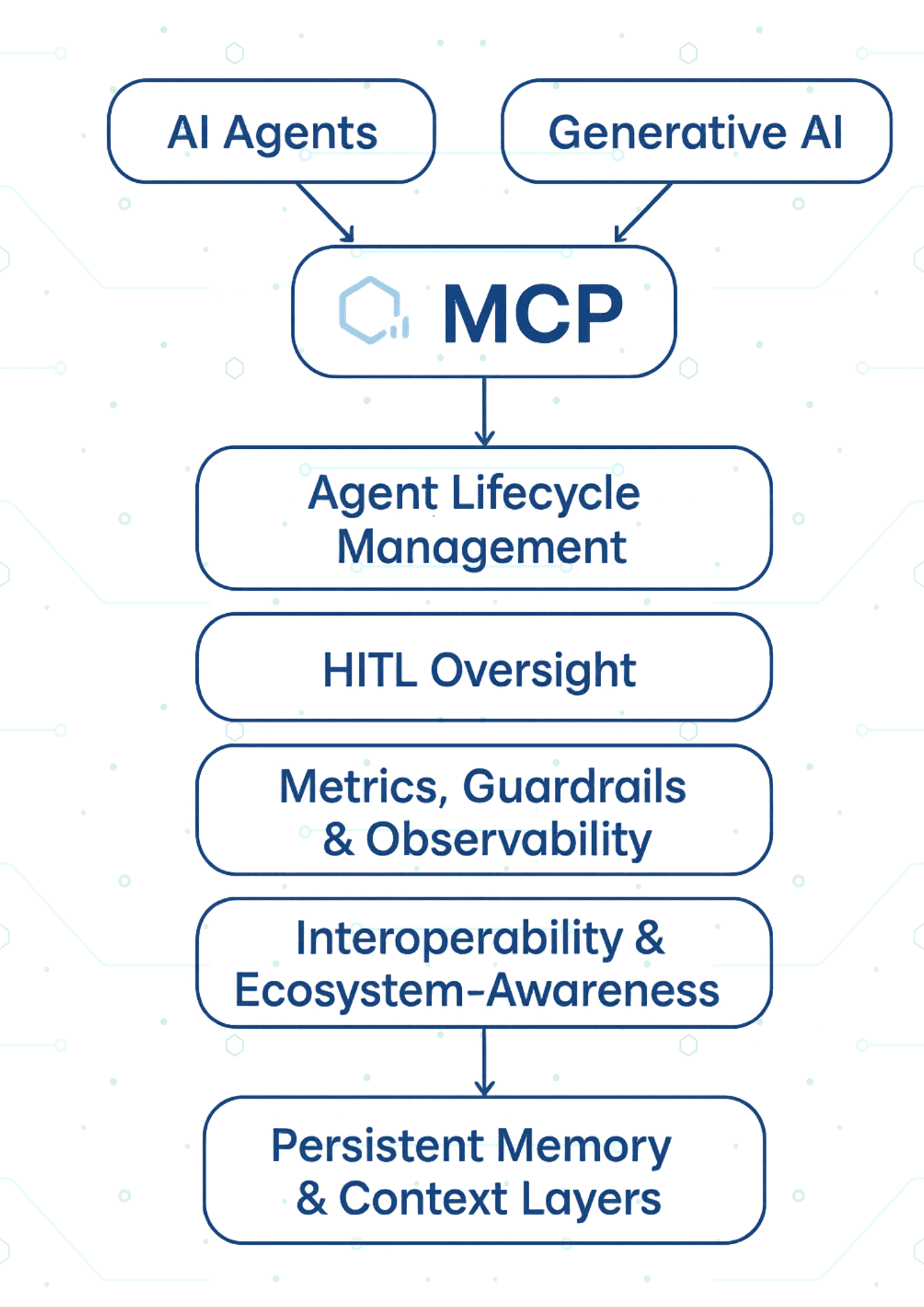From AI Agents to Agentic AI
Building Blocks of the AI Native Enterprise

Introduction
In the rapidly evolving landscape of artificial intelligence, the terms "AI Agent" and "Generative AI" have become commonplace. While these technologies have undeniably transformed various industries, their limitations become apparent when attempting to build truly robust, autonomous, and scalable enterprise-grade AI systems.
Traditional AI Agents, though capable within their defined tasks, often lack the broader contextual understanding and collaborative capabilities needed for complex, multi-step objectives. Similarly, the groundbreaking power of Generative AI, while impressive in content creation, is largely confined by its static, prompt-based nature—lacking persistent memory, dynamic orchestration, or the ability to autonomously pursue goals.
This is where Agentic AI emerges as the necessary evolution—the true AI Native path forward for enterprises. It represents a paradigm shift from isolated, task-specific automation to a collaborative ecosystem of intelligent entities capable of perceiving, reasoning, planning, and executing complex workflows with unprecedented autonomy and adaptability.
The Shift from AI Agent to Agentic AI
The distinction between a traditional AI Agent and Agentic AI lies in their scope of autonomy, orchestration capabilities, and learning mechanisms.
AI Agents are autonomous software programs designed to perform specific, well-defined tasks. They exhibit high autonomy within narrow domains and may learn within that specific context. For instance, an AI agent might manage a smart thermostat, adjusting settings based on predefined rules or learned user preferences. Initiation is typically prompt or goal-triggered, with limited ability to decompose or adapt broader objectives.
Agentic AI, on the other hand, involves systems of multiple AI agents collaborating to achieve complex, overarching goals. These systems operate with significantly higher autonomy, orchestrating multi-step processes and dynamically assigning subtasks to specialized agents. They learn from outcomes, adapt strategies, and share context via persistent task memory—enabling coordination and continuous improvement over time.
Why Generative AI Isn’t Enough
Generative AI models, such as large language models (LLMs), have revolutionized content creation and information synthesis. But as standalone tools, they fall short of enabling true enterprise-grade autonomy.
Key Limitations:
1. Persistent Memory
Generative AI typically lacks memory beyond a single prompt. It cannot recall past conversations or maintain continuity, making it unsuitable for tasks requiring long-term understanding or iterative refinement.
2. Orchestration
Generative models don’t inherently support multi-step task coordination. They can’t decompose problems, delegate subtasks, or manage workflows without being manually scripted into larger systems.
3. Autonomous Action
While capable of generating plans or suggestions, Generative AI cannot execute them. It lacks the agency to trigger actions, interact with APIs, or manage systems without external scaffolding.
Conclusion: Generative AI is a powerful reasoning engine—but without memory, orchestration, or action—it remains a "brain without a body."
Functional & Architectural Evolution
The journey from simple AI Agents to Agentic AI marks a significant shift in enterprise AI architecture.
Traditional AI Agents:
- Perceive inputs (e.g., sensor data)
- Apply static rules or narrow logic
- Execute single actions
- Operate in isolated loops
Agentic AI Systems:
- Use shared memory to retain context across agents
- Perform task decomposition from high-level goals
- Enable multi-agent collaboration
- Adapt dynamically to evolving situations
Enterprise Use Cases:
- Internal Enterprise Search: Orchestrates retrieval, summarization, and synthesis into a single response.
- Multi-Agent Research Assistants: Automate multi-step market research with role-based agents.
- Intelligent Robotics Coordination: Coordinate fleets of robots in logistics or manufacturing.
- Dynamic Email Filtering: Context-aware prioritization and auto-responses.
- Autonomous Scheduling: Optimize team calendars, resources, and project deadlines.
From Chaos to Coordination: Why Agentic AI Needs a Shared Protocol
As Agentic AI systems grow in complexity, so does the challenge of making them coherent, goal-oriented, and memory-aware.
It’s not enough to just have multiple agents—unless they understand:
- What the shared goal is
- What each agent is responsible for
- What’s already been done
- What needs to happen next
Without a unified communication layer, even the most sophisticated agents will operate in silos:
- Repeating tasks already completed
- Forgetting context across interactions
- Failing to adapt to system-wide changes
This is where most multi-agent systems begin to break down—in consistency, reliability, and alignment.

Introducing Model Context Protocol (MCP): The Missing Layer
To overcome this chaos, Model Context Protocols (MCPs) are essential.
MCP is the protocol layer that standardizes:
- How agents share context
- How memory is retained and passed along
- How each agent interprets the overall system state
Think of it as the control schema or shared mental model of the Agentic system.
With MCP, Agentic AI systems can:
- Maintain persistent memory and context between agents
- Orchestrate multi-step workflows with state tracking
- Recover from interruptions and reassign tasks
- Present human-readable logs for auditing and intervention
It transforms a fragmented collection of agents into a cohesive, goal-seeking intelligence.
Why MCP is Central to the AI Native Enterprise
In the AIC framework, MCP is not an optional layer—it’s a requirement for AI systems that aim to be:
- Orchestrated, not prompt-triggered
- Adaptive, not stateless
- Transparent, not opaque
- Composable, not hard-coded
It enables:
- Modular agent composition
- Structured task memory
- Seamless integration across LLMs, APIs, databases, and UI surfaces
- Observability and guardrails at every interaction layer
Simply put:
Without MCP, Agentic AI is just automation with extra steps.
With MCP, it becomes the operating system for AI Native Enterprises.
The AIC Lens: Agentic AI as the Core of AI Native Architecture
At AIC, the vision of the AI Native Enterprise rests on foundational pillars—each of which aligns closely with Agentic AI.
1. Model Context Protocols (MCPs)
Agentic AI depends on shared understanding between agents. MCPs provide structured frameworks for agents (and models) to communicate, share goals, and interpret context consistently across workflows.
2. Persistent Memory & Context Layers
Agentic systems maintain episodic and task memory, allowing them to remember goals, track progress, and adapt continuously. This long-term memory is essential for evolving enterprise processes.
3. Agent Lifecycle Management
From instantiation to retirement, agents can be dynamically managed. Agentic systems support spawning new agents, reallocating tasks, and adapting agent behavior to new needs.
4. Human-in-the-Loop (HITL) Oversight
Autonomy doesn’t exclude human input. Agentic systems are designed to surface decision points for human review, providing guidance or final approval as needed.
5. Metrics, Guardrails & Observability
Agentic workflows are transparent and observable. Each agent and task can be monitored for performance, cost, accuracy, and compliance, with guardrails embedded into orchestration logic.
6. Interoperability & Ecosystem Awareness
Agentic AI integrates across APIs, tools, and platforms. Agents can interface with legacy systems, cloud tools, or external models—making them modular and enterprise-ready.
Trends and Adoption
Google Trends data shows a sharp rise in searches for "Agentic AI" beginning in late 2024. This surge highlights industry interest in moving beyond prompt-based models to orchestrated AI systems.
As enterprises hit the limits of siloed tools and stateless LLMs, the need for adaptive, goal-driven intelligence becomes clear. Agentic AI is gaining ground as the architecture of choice for AI-native transformation.
Conclusion: Agentic AI is the Future
Enterprises that continue to rely solely on static, prompt-based Generative AI will struggle to scale intelligent operations. Agentic AI offers a better path: one that is autonomous, adaptive, and collaborative by design.
By integrating persistent memory, orchestration logic, modular agents, and observability layers, businesses can transform from AI-enabled to truly AI Native. This shift unlocks deeper automation, faster decision-making, and resilient operational models.
Is Your Architecture AI Native-Ready?
If your current systems:
- Forget context
- Work only on prompts
- Can’t coordinate across functions
Then it's time to reimagine your architecture. Visit aiinchief.com to explore blueprints, frameworks, and expert guidance for building Agentic, AI Native Enterprises.

